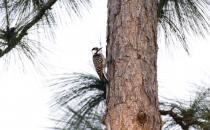Trump administration finalizes rule narrowing habitat protected by Endangered Species Act
In its final days in office, the Trump administration is continuing its assault on environmental regulations. The administration finalized a rule in the last days of the year that will weaken the Endangered Species Act by making it more difficult to protect areas as critical habitat for threatened and endangered species.
The rule establishes a narrow definition of “habitat” — a term that Congress and regulators have never thought needed defining in the 50 years since the Endangered Species Act, or ESA, was passed.
For purposes of defining critical habitat under the ESA, the rule limits habitat to areas that contain “the resources and conditions necessary to support one or more life processes of a species.” The problem is, the final rule excludes habitat areas needed to ensure recovery of imperiled species, according to SELC Staff Attorney Ramona McGee.
“The final definition remains very focused on whether an area could support a species today,” said McGee. “This could exclude important habitat from protection—including habitat that might become important as an endangered or threatened species shifts its range in response to climate change, as well as habitat that is currently degraded or fragmented and requires restoration to support imperiled species.”
The final rule’s limitation of this definition to the critical habitat context appears to restrict its reach somewhat, compared to the two more broadly defined alternatives originally proposed by the U.S. Fish and Wildlife Service and National Marine Fisheries Service.
“The good news is the agencies at least heard our concerns about how the earlier, proposed definitions were not limited to critical habitat,” said McGee. “But this rule change could still have severe consequences for ecosystems across the Southeast. Defining habitat by regulation is unnecessary. The Endangered Species Act has seen 50 years of extraordinary success without it.”
Habitat conservation is a vital component of protecting species from extinction. Habitat degradation and loss is the leading cause of extinction. Keeping degraded habitat from being eligible for critical protections could seriously undermine the conservation and recovery of at-risk species. Erosion controls and development in the Southeast have already damaged places vital to coastal species’ survival—including shorebirds like piping plovers, beach mice like the Alabama beach mouse, and sea turtles like loggerhead turtles.
Similarly, many species’ historic habitat ranges will shift as a result of climate change, but the new definition will prevent federal officials from designating areas that are likely to become habitat in the near future due to climate change. Birds, reptiles, amphibians, marine species, cold-water aquatic species, and high-elevation species will be particularly susceptible to climate-change driven range shifts.
Across the Southeast, there are currently 255 species that receive protections under the Endangered Species Act by their classification as endangered (176), threatened (76), or experimental populations (32).

